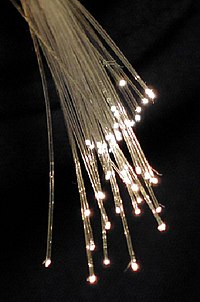
Photo from wikipedia
Abstract Cadmium sulphide (CdS) and Mn-doped CdS nanocrystals were synthesized by co-precipitation method. The nanocrystals were characterized by Fluorescence, Fourier Transformed Infra-red Spectrometer (FTIR), UV–Visible, X-ray diffraction (XRD), X-ray photoelectron… Click to show full abstract
Abstract Cadmium sulphide (CdS) and Mn-doped CdS nanocrystals were synthesized by co-precipitation method. The nanocrystals were characterized by Fluorescence, Fourier Transformed Infra-red Spectrometer (FTIR), UV–Visible, X-ray diffraction (XRD), X-ray photoelectron spectrometer (XPS), Field Emission Scanning Electron Microscope (FESEM), and High Resolution Transmission Electron Microscope (HRTEM). A considerable blue shift of absorption band with respect to the cadmium sulphide was observed by the Mn concentration (0.5 M) in the doped sample with decreasing the size of nanocrystals. Other reason for this may be Mn doping. Subsequently the band gap was altered from 2.11 to 2.21 eV due to quantum confinement effect. Scanning electron microscope supplemented with EDAX was operated to find grain size and chemical composition of the synthesized nanomaterials. The PL spectrum of Mn-doped CdS nanocrystals displays three PL bands the first one, within the range of 500 nm and the second band at 537 nm, and the third one around 713 nm is labelled red band emission due to attributed to a 4T1→6A1 transition within the 3d shell of divalent manganese. XRD analysis showed that the material was in cubic crystalline state. A comparative study of surfaces of un-doped and metal doped CdS nanocrystals were investigated using X-ray Photoelectron Spectroscopy (XPS). The synthesized nanomaterial in combination with polymer, poly (3-hexyl thiophene) was operated in the construction of photovoltaic cells. The photovoltaic devices with CdS nanocrystals exhibited power conversion efficiency of 0.34% without annealing and 0.38% with annealing. However, the power conversion efficiency was enhanced by a factor of 0.35 without annealing and 0.42 with annealing with corporation of Mn impurity in CdS lattice. Atomic Force Microscopy was employed for morphology and packing behavior of blend of nanocrystals with organic polymer.
Journal Title: Optical Materials
Year Published: 2018
Link to full text (if available)
Share on Social Media: Sign Up to like & get
recommendations!